________________
m
hp
The term 'Jain Studies' is not without its critics who point to its uneasy closeness to 'Jain studies' and to its artificially narrow thematic focus. Academic research on the Jain tradition has been pioneered in the Departments of Indology which were introduced into European Universities during the first half of the 19th PA Century (only to be slowly abolished again in the first half of the 21st century). The pioneers of Jaina Studies were professional philologists who studied not a religious group or a set of religious practices but Indian or Indo-European languages and literature in general, in this case the Prakrits which distinguish the Jain scriptures from the Brahmin and Buddhist scriptures. In recent years the focus of academic research has shifted from the earlier purely philological (philosophical and archaeological) endeavour to the study of Jainism as a living religious tradition. For the first time, Jainism itself is taught outside India at University level at Departments of the Study of Religion which alone provide a thematic focus on one or other religion. They work closely together with other disciplines, and with the religious communities concerned, without jeopardizing their academic independence and objectivity.
098
related educational activities can be noted in Britain before the arrival of the East African Jain Diaspora from 1967 onwards. Understandably, the new migrants were more narrowly focused on the educational needs of their own communities, than the short-term Jain visitors two generations earlier. They established institutions for community education such as the Jain Pathshala in Leicester 1973-1977, Chandana Vidyapith in London 1998, and Jain Vishva Bharati London 2003, and organised shibirs and other educational events. In addition, Jain community organisations such as the Institute of Jainology, the Jain Academy, and Jain Spirit promoted an Adult Education course on Jainism at the Faculty of Continuing Education at Birkbeck College in London 1997, and University degree courses on Jainism at De Montford University in Leicester 1994-1997, and at SOAS in 1999, where 45 of a total of 79 degree and non-degree students of Jainism have achieved BA and MA degrees to date. Though the interest in the academic study of Jainism continues to remain low amongst 'born' Jains, even if combined with a professional degree, the enthusiasm for Jaina Studies is increasing amongst the wider public and amongst professional academics and teachers. In Britain, the growing interest in Jainism and in the Jain way of life is reflected in the increasing number of publications on the Jain tradition, in public exhibitions such as Peaceful Liberators at the Victoria and Albert Museum in London in 1996 and Steps to Liberation at the Ethnographisch Museum of Antwerpen in 2000, and in the new Centre for Jaina Studies, the first of its kind outside India, which was founded by SOAS in March 2004 to host regular international Jaina Studies Workshops and Annual Jaina Lectures at SOAS and to promote teaching and research of the Jain tradition at the University of London.
This short overview shows that the institutional history of Jaina Studies cannot be understood in isolation from the political, social and cultural contexts which prompted the invention of 'Jainism' as an independent 'religion' in the 19th century and the institutionalization of 'Jaina Studies' in the late 20th and early 21st centuries. It may well be that we are presently witnessing the uncoupling of the doctrines of Jainism from the
traditional institutional bedrock of the Jain communities and the establishment of a universal religion of non-violence embodied in a set of texts which, after their release from the vaults of the bhandaras and the monopoly of interpretation of the acharyas, gained a life on their own in the form of printed or electronic texts which are freely available to anyone anywhere. Jainism as a disembodied text-based set of idea-ologies or dogmas from which one can pick and chose can be individually interpreted and applied in manifold ways without sanction. The consequences of this ongoing development from ritual to reflection for the future of the Jain tradition have to be seen.




